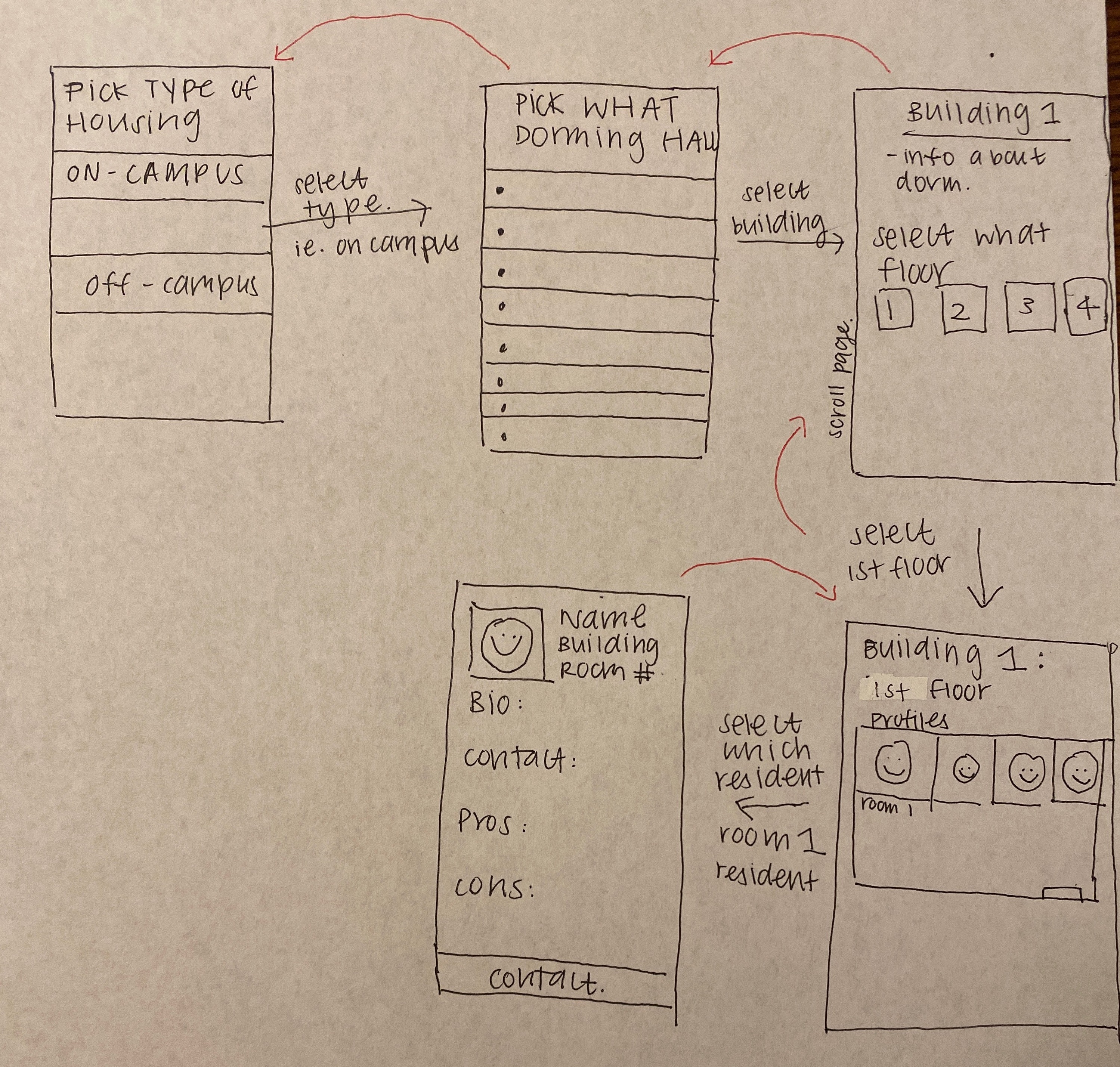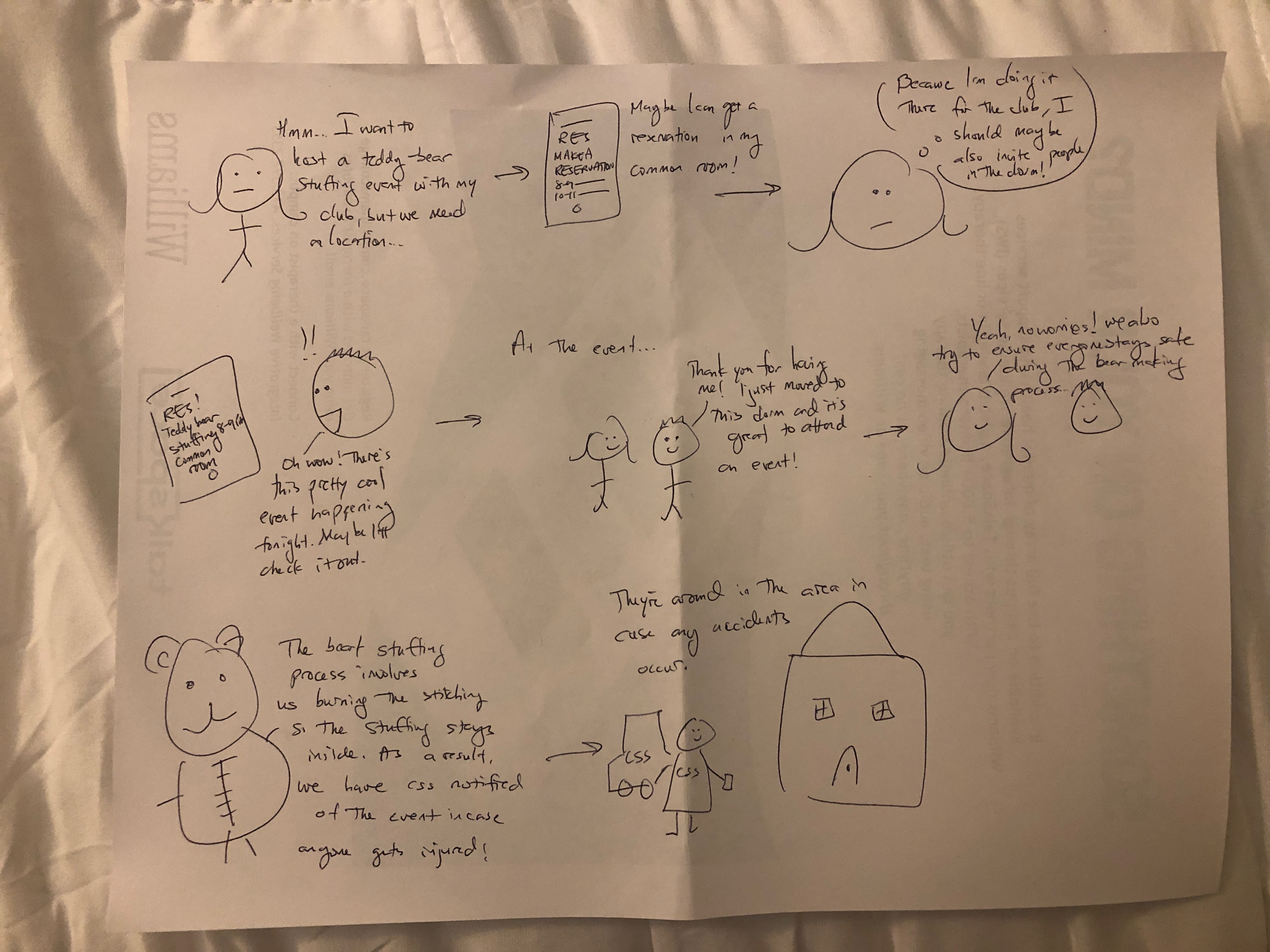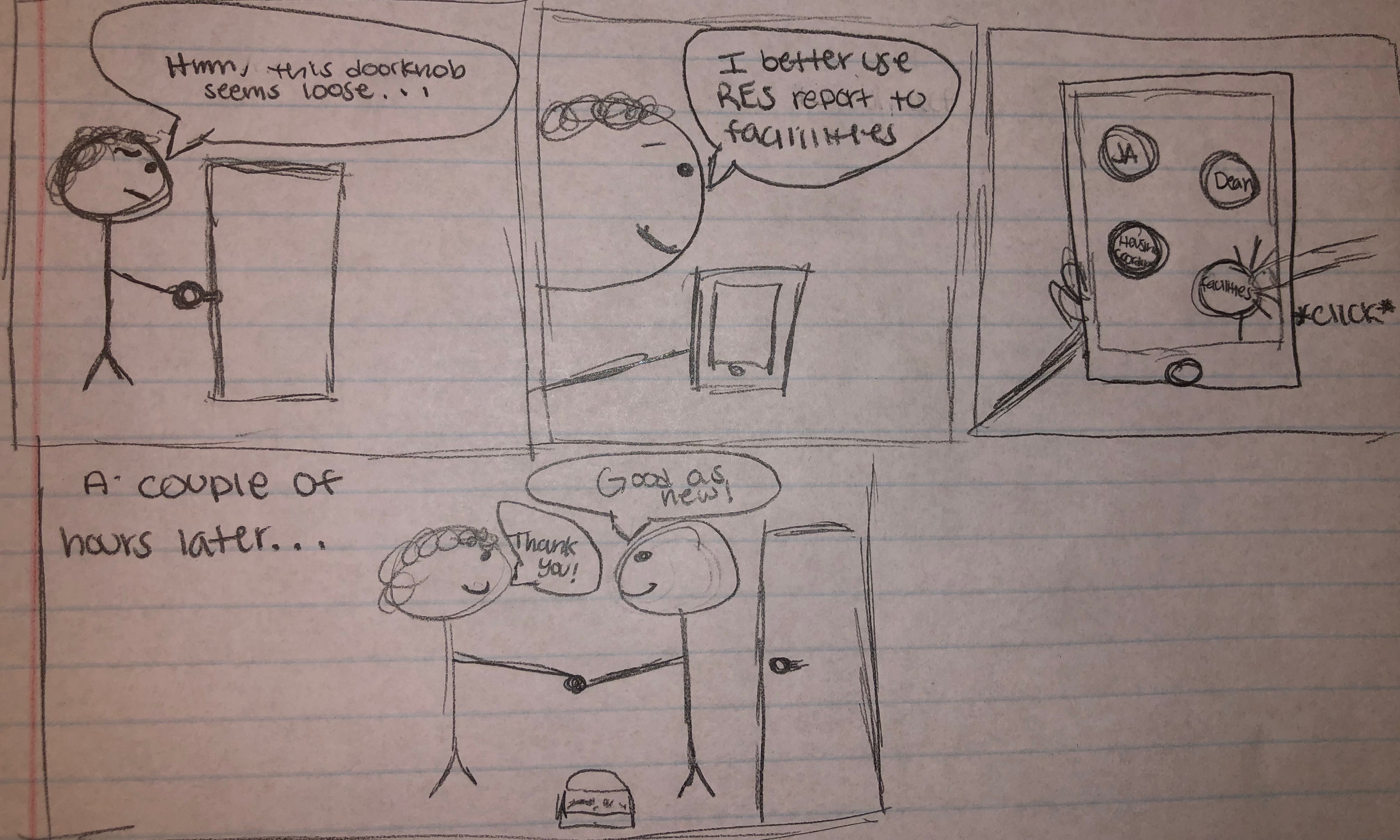Recap of Tasks
1. Getting in contact with housing authorities - Easy
Lauren is a first year student who constantly asks her JA for help because she doesn’t really know how to contact the housing authorities such as facilities and CSS on her own. She finds the majority of her information on the college website, but a lot of the information seems to be outdated. On the website, there was a lot of profiles about other employees as well, and she didn’t know whether to contact the manager or director of facilities. She once contacted the housing director through the website’s contact information, but it took them a week to get back to her! The process was very slow and frustrating for her. It would be useful for her to know specifically who to contact when she needs the help.
2. Getting Information on student housing options - Easy
Alex is a 3rd year student who wants to live off campus during their senior year. Alex tries to contact local real estate agents to ask about some of the apartments and houses that current seniors are living in. The real estate agents say that they do not deal with the properties that Alex is interested in but give Alex detailed information about other properties. As Alex looks at this information, they do not understand it and do not know whether the information is sufficient for approval of their request to live off campus by their school. Alex declines the information from the real estate agents and tries to figure out who is living off campus this school year. While they do not know which students these are because they have never met them, they must find a way to get in contact with these seniors to move on in the process of potentially living off campus the following year.
3. Creating a social space where you live - Hard
Nathan is a sophomore who really enjoys playing video games. He wants to set up his video game console in his hall’s common room but the sports team that lives in the same hall always occupies it. As a result, he could never spend time in the common room without the team being there. He found a group of friends also interested in video games, but they don’t have a large enough space to play. Nathan wishes there was a way for him to reserve the common room so that he can create a social space for him and his video game friends to play in.
4. Give Feedback on your housing - Easy
Derek is a junior entering his senior year and is looking for dorms to live in. He is really excited to live in an upperclassman building but is unsure of which rooms are more desirable. He visits the building and knocks on people’s doors to ask if he could quickly look through the room setup. While the room setup is online, there is little information about general amenities such as mirrors and what the windows are like. Derek wishes there is an easier way for him to access this information without needing to ask people which may make certain people living in those rooms feel uncomfortable.
5. Getting To Know Your Neighbors - Hard
Lily lives in a large dorm but sees how much fun her neighbors seem to have on the weekends and wants to get to know them. She thinks that the best way to get to know these people is over a meal. She does not know any of the people that she was placed in her dorm with, and is too shy to approach them in person. She is unsure of how she should get in contact with these people. Lily does not have a mutual friend to introduce them so thinks of using social media as an alternative. She then realizes that this would be awkward given the fact that her and the people that she wants to get to know don’t even know each other’s names. Lily wishes that there were a way to contact these people on a standard platform where they could recognize that she lives in the same dorm as them if she were to reach out.
6. Moving Into a New Place - Moderate
John is a first year student who has just moved into a dorm room for the first time. He realizes that there are items that he will now need to buy himself after he moved in because he was unsure of whether or not they would be provided. Some of these items include hangers, a desk lamp, and a full length mirror. John even needs to buy special tape, instead of the thumbtacks he brought with him, to hang items on his brick walls. He finds a way to get all the items himself once school has started but he is frustrated. John even decides to write a list of all these items so that he can refer to it before moving in the following year. Although, he is unsure of whether his future dorm rooms will provide the same things because he has heard from others who have lived in dorms that include some of the items he has bought for himself this year.
Design Idea #1
This will be a mobile app with a visual directory of all the residents’ profiles that lists contact information, a biography, and also what they like and don’t like about the space they are currently living in. There will be a list of all living spaces associated with the colleges’ students (even off campus apartments). The user will be able to pick which building they want to see and the floor plan will give access to the residents’ profiles.

Tasks:
-
Getting Information on student housing options (Easy): First, the visual directory will make the user pick what they want to see between on campus and off campus housing. Since there will be a list of buildings/residential halls for each category, the user will be able to explore all the different options in terms of housing. For each building, there will be information about the facilities and resources that are available. The benefit of this design is that the information will be consolidated, easily accessible, and organized by category.
-
Give Feedback on your housing (Easy): Each resident’s profile shows where they are living and how they feel about their current living situation. Having feedback from the current residents makes it more reliable. Users are able to give their honest opinion for future residents, but it will also notify the housing authorities about certain problems they faced.
-
Getting To Know Your Neighbors (Hard): The user would be able to get more information about their neighbors by looking at their residents’ profiles on the floorplan. Since there is the contact information and a biography (listing hobbies, interests, career, major, & etc.), it would make the user have an easier time to connect with the people around them. Through this design, we want to normalize the reaching out process and increase social engagement.
-
Moving Into a New Place (Moderate): Having a contact person that is familiar with the area would be useful when moving into a new place. This could help people gage what they need before the whole moving process. Users could contact current residents with questions to ease this transition. Having buildings’ specifications such as the floorplan, amenities, and facilities beforehand helps the user envision their new residency.
Design Idea #2
A feature of our design is connecting people living in the same dorm by sharing events members of the dorm are hosting. Meeting people within the dorm system is especially difficult after the first-year entry system where people no longer gather in common rooms to meet everyone else and everyone picks into dorms with a select friend group. We will implement an event system where people can reserve public spaces in the building such as the common room or the kitchen to host events. These events can also be public so that everyone in the building will be notified of it and is welcome to attend.

Tasks:
-
Getting in contact with housing authorities (Easy): By sharing the events on RES, housing authorities such as the housing coordinator are aware of the event happening. As a result, they can ensure safety precautions are taken. Sharing events that may be dangerous can also involve Campus Safety & Security, where trained adults may need to be in the space as an extra precaution.
-
Creating a social space where you live (Hard): This lets people reserve the space (e.g. common rooms) so that there wouldn’t be any conflicts over which space belongs to who at a given time. Additionally, because events can be shared with the dorm, people that are interested are free to join the social space and be a part of it.
-
Getting To Know Your Neighbors (Hard): Getting to know people living in your dorm building becomes harder when you leave the first-year entry system. Directly inviting people in your dorm to events may also put uninterested people in an uncomfortable position where it may be harder for them to say no. As a result, the use of sharing events to the dorm spreads the word quickly and seamlessly where people who are interested can attend and those not interested won’t feel pressured to, creating a more natural environment for people to get to know each other.
-
Moving Into a New Place (Moderate): Moving into a new place may mean not knowing the people in your new dorm. It is difficult to branch out and as a result this event design helps people publicize their events so that anyone can attend. This makes it easier for people who just moved into a dorm to meet others that live there.
Design Idea #3
We want to create a reporting system on our mobile app where students can notify housing authorities if they have any issues with their housing. These issues can be a range of different housing related problems. An example of a problem that could be reported on RES is a problem regarding the habits of the people that live in the same dorm, such as a specific individual constantly playing loud music at inappropriate hours. Another example is a problem of damage to the dorms themselves, such as a loose door handle shown in the drawing below. Students only have to press the appropriate button on the RES app to immediately notify individuals such as housing coordinators, junior advisors, deans, or facilities to help resolve these issues more quickly.

Tasks:
-
Getting in contact with housing authorities: This design idea clearly accomplishes this task by allowing students to easily get in contact with housing authorities. The contact information of various types of housing authorities is centralized within this feature of the app. Having this information in one place will be useful for students and allow them to reach out to housing authorities more freely when needed.
-
Getting Information on student housing options: This reporting feature helps with this task because a better feedback system makes it easier for students to reason through logistics regarding housing options, further encouraging the sharing of this information with each other. When students are communicating about their housing problems with housing authorities more, they are thinking about their living experience more often and can therefore articulate it better. This will make communication regarding housing options better among students, allowing for better sharing of housing information.
-
Give Feedback on your housing: The design idea accomplishes this task by making communication of housing feedback more accessible through increased communication. When students have more communication regarding issues with housing authorities, this creates more of an opportunity to speak about their living experiences as a whole. While this is an informal method of giving feedback, it is still effective since these conversations are happening with the people who can actually make a difference when it comes to housing experience.
-
Moving Into a New Place: A reporting system on RES accomplishes this task by making moving in easier due to the fact that issues in a new living space can be resolved quicker. When students are moving into a new place, everything will not always go smoothly and because they are new, they do not always know who to reach out to. RES Report will help resolve these issues in a timely manner with low stress on the new student acclimating to a new environment and therefore making their move in experience better.